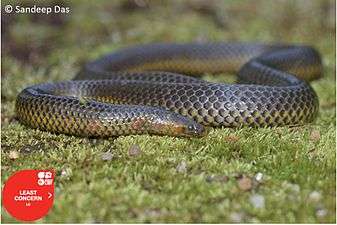Uropeltis rubromaculata
Uropeltis rubromaculata is a nonvenomous shield tail snake species endemic to southern India. No subspecies are currently recognized.[3]
| Uropeltis rubromaculata | |
|---|---|
 | |
| Scientific classification | |
| Kingdom: | Animalia |
| Phylum: | Chordata |
| Class: | Reptilia |
| Order: | Squamata |
| Suborder: | Serpentes |
| Family: | Uropeltidae |
| Genus: | Uropeltis |
| Species: | U. rubromaculata |
| Binomial name | |
| Uropeltis rubromaculata (Beddome, 1867) | |
| Synonyms | |
| |
- Common names: red-spotted earth snake.
Geographic range
It is found in southern India in the Western Ghats in the Anaimalai Hills and Nilgiri Hills between 1,200 and 1,500 m (3,900 and 4,900 ft) elevation.
The type locality given is "Anamallay forests; 4,000 feet elevation".[2]
Description
Dorsum olive-brown. Some red blotches on each side of the anterior portion of the body, and one red blotch on each side of the tail near the vent. Ventrum variegated with yellow and red.
Adults may attain 34 cm (13 3⁄8 in) in total length.
Dorsal scales arranged in 17 rows at midbody, in 19 rows behind the head. Ventrals 127-136; subcaudals 8-10.
Snout obtuse. Rostral slightly more than ¼ the length of the shielded part of the head. Portion of rostral visible from above as long as its distance from the frontal. Nasals in contact with each other behind the rostral. Frontal slightly longer than broad. Diameter of eye ½ or slightly more than ½ the length of the ocular shield. Diameter of body 25 to 33 times in the total length. Ventrals two times as broad as the contiguous scales. End of tail flat dorsally, obliquely truncate, with strongly bicarinate or tricarinate scales. Terminal scute with a transverse ridge and two points.[4]
References
- Srinivasulu, C.; Srinivasulu, B.; Ganesan, S.R. & Vijayakumar, S.P. (2013). "Uropeltis rubromaculatus". The IUCN Red List of Threatened Species. IUCN. 2013: e.T178483A1536535. doi:10.2305/IUCN.UK.2013-1.RLTS.T178483A1536535.en. Retrieved 10 January 2018.
- McDiarmid RW, Campbell JA, Touré T. 1999. Snake Species of the World: A Taxonomic and Geographic Reference, vol. 1. Herpetologists' League. 511 pp. ISBN 1-893777-00-6 (series). ISBN 1-893777-01-4 (volume).
- "Uropeltis rubromaculata". Integrated Taxonomic Information System. Retrieved 2 September 2007.
- Boulenger, G.A. 1893. Catalogue of the Snakes in the British Museum (Natural History). Volume I., Containing the Families...Uropeltidæ... Trustees of the British Museum (Natural History). London. p. 157.
Further reading
- Beddome, R.H. 1867. Descriptions and figures of Five New Snakes from the Madras Presidency. Madras Quart. J. Med. Sci., 11: 14-16. [Reprint: J. Soc. Bibliogr. Nat. Sci., London, 1 (10): 315- 317, 1940.]
- Beddome, R.H. 1886. An Account of the Earth-Snakes of the Peninsula of India and Ceylon. Ann. Mag. Nat. Hist. (5) 17: 3-33.
External links
- Uropeltis rubromaculatus at the Reptarium.cz Reptile Database. Accessed 2 September 2007.
